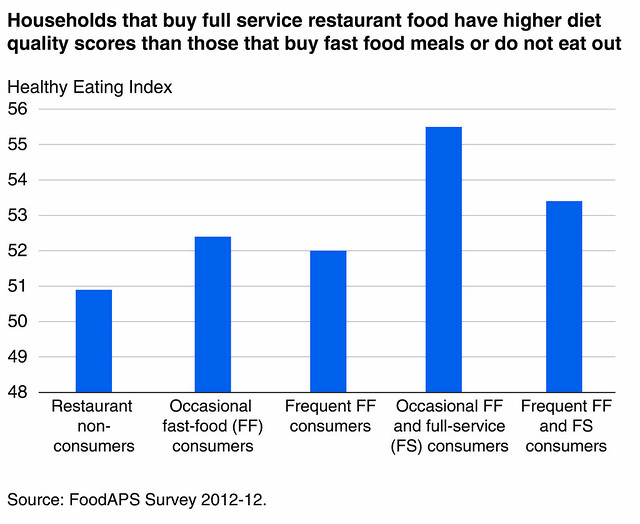
Every day, we make decisions about what to eat. And what we eat plays an important role in our body weight and long-term health. Given the high obesity rates in the U.S., a growing number of researchers are asking: how important is geographic access to restaurants in people’s food choices? Some observers argue that the abundance of high-calorie, less nutrient-dense restaurant fare is to blame for Americans’ poor diets and expanding waistline.
In our recent study, “How Food Environment and Proximity to Restaurants Affect Nutritional Quality,” we use USDA’s 2012-13 National Household Food Acquisition and Purchase Survey (FoodAPS) to explore how the number of and proximity to full-service restaurants (restaurants with wait staffs) and fast-food restaurants (restaurants with counter service) relate to food choices and diet quality.
Our study suggests that households that frequently purchase fast-food tend to live closer to fast-food restaurants than households that do not eat out, though the difference in proximity is small. Our results find no relationship between either the number of, or proximity to, full-service restaurants and how often households visit full-service restaurants.
We find little evidence that the frequency of fast-food purchases is related to poor diet quality (i.e., adherence to the 2010 Dietary Guidelines). In fact, households that frequently buy fast food were found to have higher diet quality scores than those who do not eat out. However, the frequent fast-food purchasers also tend to have higher incomes than households that do not eat out. Previous studies show that higher income is generally associated with healthier diets.
Households that patronize full-service restaurants have higher diet quality scores relative to those that only patronize fast-food restaurants and those that do not eat out. Again, this relationship is likely driven by income rather than the healthfulness of full-service restaurant meals.
The study’s findings indicate that socioeconomic status appears to play an important role in food choices, perhaps more so than geographic access. However, since our exploratory study looked at correlations and did not control for socioeconomic factors, such as income or education, further research is needed to address that question.
Our study is part of the recent report, America’s Eating Habits: Food Away From Home which explores three broad research areas of Food Away From Home: (1) food choices and availability; (2) nutrition and diet quality; and (3) food policies, including menu labeling and food assistance programs.
